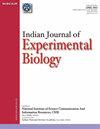Effects of Gonadotropins on Blood, Bone Marrow, and Spleen in Cyclophosphamide-Exposed Rats
IF 0.5
4区 生物学
Q4 BIOLOGY
引用次数: 0
Abstract
Cyclophosphamide (CTX) is an effective chemotherapeutic agent. Gonadotropins are molecules with various actions. We investigated the effects of gonadotropins on the peripheral blood, bone marrow, and spleen in rats given CTX. Three groups were formed: Control (C) group with no process; Sham (S) group: Physiological saline was applied; CTX group: A single dose of 200 mg/kg and 8 mg/kg CTX was administered for the next 14 days. All rats were superovulated with 150-300 IU/kg pregnant mare serum gonadotropin. 150-300 IU/kg Human chorionic gonadotropin was given, and complete blood counts, bone marrow smears, and spleen sections were examined; the expression of WNT-1, WNT-4, and β-catenin was analyzed. Although the hemoglobin and platelet value in the CTX group was lowest, it was still within the normal reference ranges. The C and S groups had significantly higher white blood cell values (p=0.017). In terms of number of megakaryocytes, Myeloid/ Erythroid ratio, lymphoid cell ratios, no significant differences were found in bone marrow aspiration smears. The CTX group had significantly higher β-catenin expression in the red pulp than the other groups (p=0.0001). The CTX group had the highest WNT-4 expression and very intense expression of WNT-1 in the white pulp. In conclusion, gonadotropins, promising in "treatment", have favorable effects on toxicity of CTX.促性腺激素对环磷酰胺暴露大鼠血液、骨髓和脾脏的影响
环磷酰胺(CTX)是一种有效的化疗药物。促性腺激素是具有多种作用的分子。我们研究了促性腺激素对给予CTX的大鼠外周血、骨髓和脾脏的影响。分为三组:Control (C)组,无工艺处理;Sham (S)组:应用生理盐水;CTX组:CTX单次给药200 mg/kg和8 mg/kg,连续14天。孕母马血清促性腺激素150 ~ 300 IU/kg,使大鼠超排卵。给予人绒毛膜促性腺激素150 ~ 300 IU/kg,检查全血计数、骨髓涂片、脾切片;分析WNT-1、WNT-4、β-catenin的表达。虽然CTX组的血红蛋白和血小板值最低,但仍在正常参考范围内。C组和S组的白细胞显著升高。值(p = 0.017)。在巨核细胞数量方面,髓系/红细胞;骨髓抽吸涂片中淋巴样细胞比例差异无统计学意义。CTX组红牙髓中β-catenin的表达显著高于其他组(p=0.0001)。CTX组白牙髓中WNT-4表达量最高,WNT-1表达非常强烈。综上所述,促性腺激素具有良好的“治疗”作用,对CTX的毒性具有良好的作用。
本文章由计算机程序翻译,如有差异,请以英文原文为准。
求助全文
约1分钟内获得全文
求助全文
来源期刊
CiteScore
1.57
自引率
33.30%
发文量
84
审稿时长
6 months
期刊介绍:
This journal, started in 1963, publishes full papers, notes and reviews in cell biology, molecular biology, genetic engineering, endocrinology, reproductive biology, immunology, developmental biology, comparative physiology, radiation biology, chronobiology, microbiology, pharmacology, toxicology and other biological fields including instrumentation and methodology. The papers having experimental design involving alteration and/or manipulation in biological system(s) providing insight into their functioning are considered for publication. Studies involving higher animals, human beings and of clinical nature are not encouraged for publication in the journal.

 求助内容:
求助内容: 应助结果提醒方式:
应助结果提醒方式:


